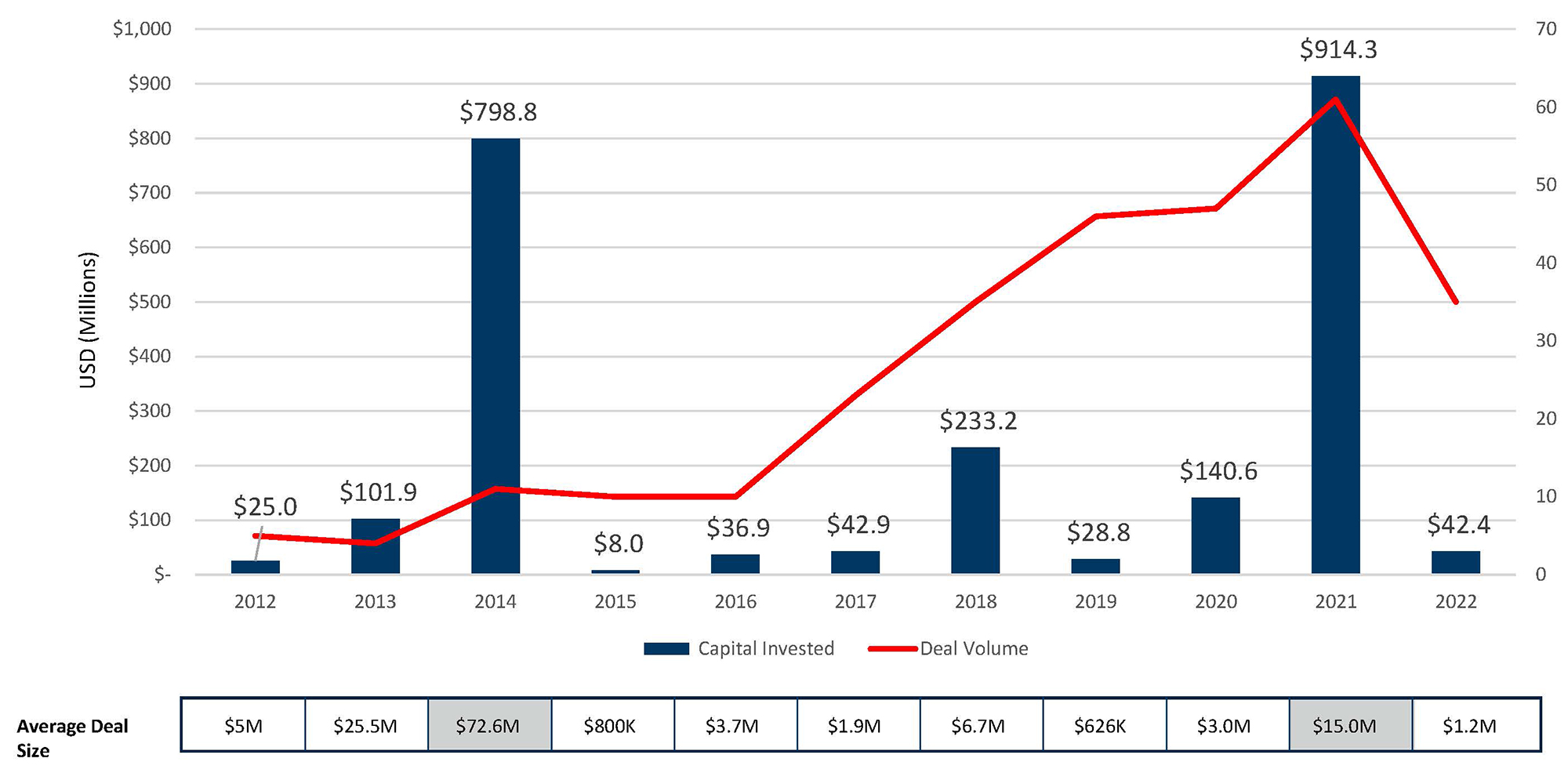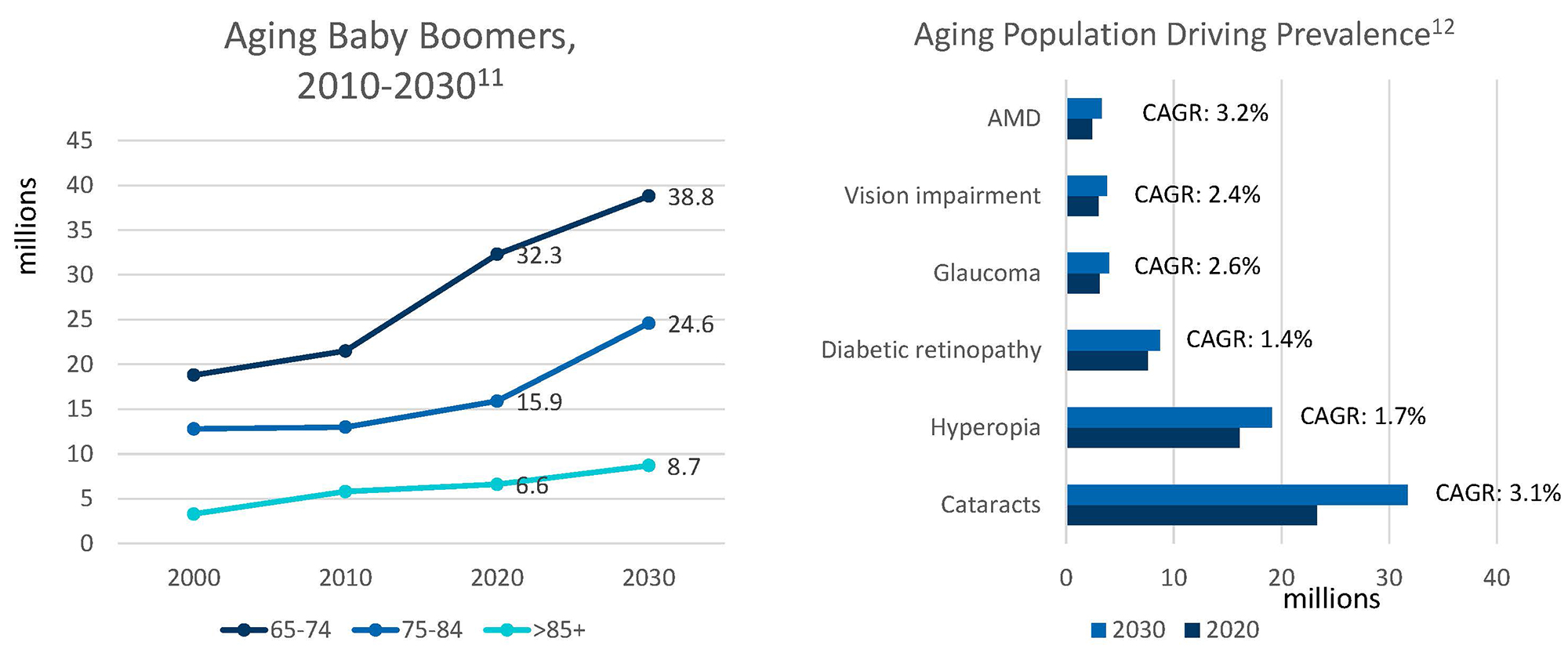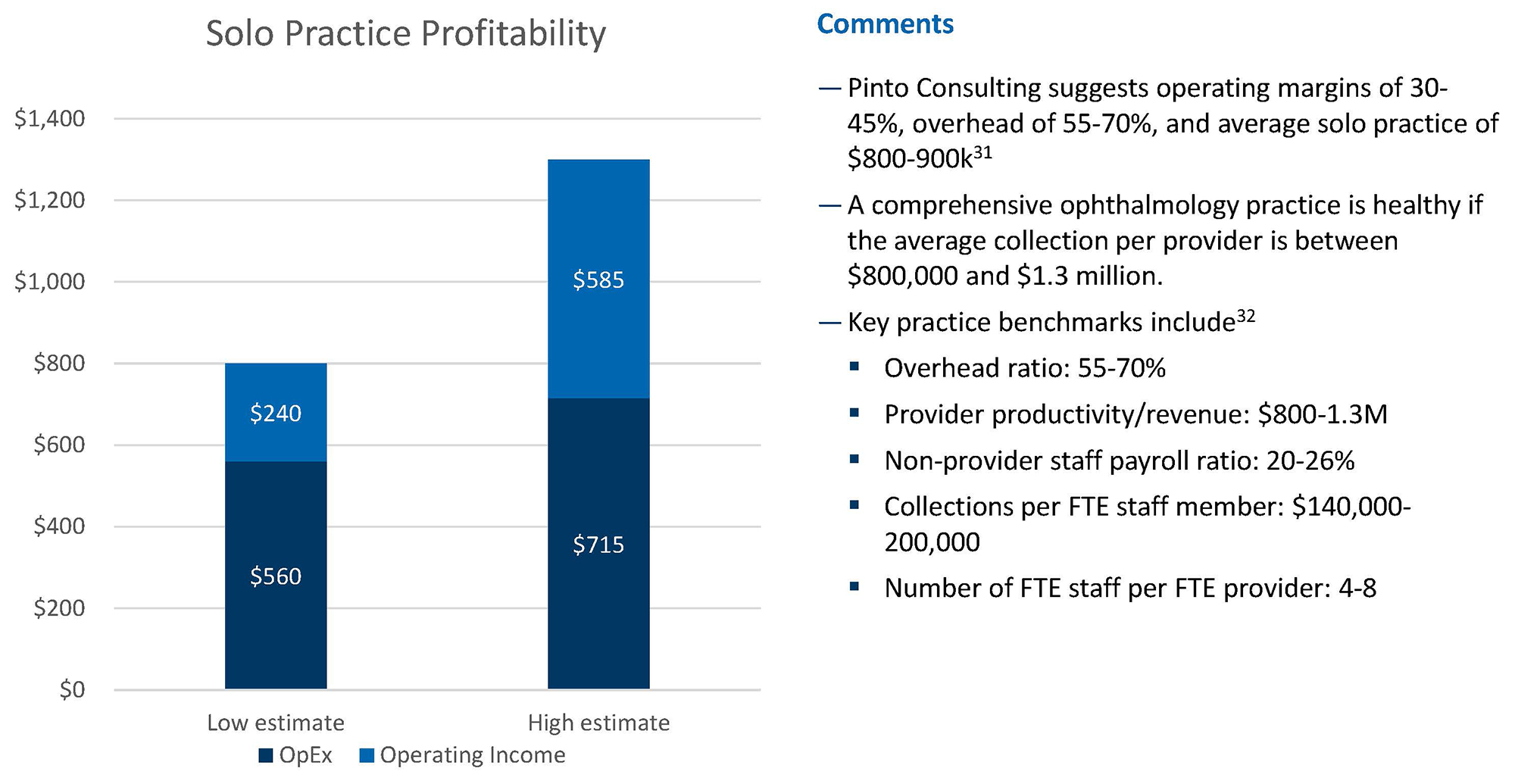Ophthalmology: A Vision for the Future
-
April 23, 2024
-
Despite a decline in deal activity observed in 2022, ophthalmology continues to be an attractive sector for private equity investment due to several factors. The first being a notable rate of procedural expansion, evidenced by a Compound Annual Growth Rate (“CAGR”) of 3.4%. A few additional factors include the presence of out-of-pocket procedures such as LASIK and oculoplastic surgeries, alongside the utilization of ancillary services such as ambulatory surgery centers, further enhances its attractiveness to investors. Although total investment reached its peak in 2021 with an average deal size of $15.0 million, a notable contrast from the $72.6 million seen in 2014, the sector remains attractive despite the slowdown in deal flow in 2022, which saw 35 transactions with an average deal size of $1.2 million.1
Ophthalmology Investment Peaked in 2021
In this article, we highlight an aging population leading to strong procedural growth, reimbursement, clinical innovation and emerging medical technologies, practice profitability and the role of Ambulatory Surgical Centers.
Private Equity Consulting Learn more
Aging Demographics a Positive Catalyst for Procedure- (and Market-) Growth
The U.S. population is aging rapidly, with an anticipated increase of the 65+ population from 56.1 million in 2020 to 73.1 million in 2030.2 Growth is highest for the 75-84 cohort, at a compound rate of growth (“CAGR”) of 4.5%, followed by the 85+ (2.8%) and 65-74 (1.9%) cohorts.3 The 65+ population is projected to make up approximately 21% of the total U.S. population by 2030.4
Common age-related conditions include cataracts, presbyopia (far-sightedness), diabetic retinopathy, glaucoma and age-related macular degeneration.5 The prevalence of these conditions increases 7-10x by age 80; cataracts affect 70% of individuals in this cohort.6,7,8 The overall procedural compound annual growth rate through 2030 is 3.4%.9 Assuming a 1.1% price increase implies a sustainable market growth rate of 4.5%.10
Ophthalmic Epidemiology Trends
In 2020-2030, the population >65 is increasing at a CAGR of 2.8% as compared to those <65, 0.2%. Growth is highest in the 75-85 years old cohort, the period of rapid growth in select eye conditions such as Acute Macular Degeneration and glaucoma.
Medicare Reimbursement Represents an Investment Risk
Most eye surgeries, including cataract removal surgeries, are categorized as “global” surgeries — a group of clinically related services coded and billed for as a single unit.13 This includes surgical procedural services and related preoperative and postoperative services to evaluate the beneficiary. Medicare pays for these services with a single payment — the global surgery fee. CMS bases global surgery fees on the cost of the surgery and the average number of related postoperative services required during the global surgery period of either 10 or 90 days.14
Medicare is the predominant payer for many common ophthalmologic procedures and accounts for approximately 50% of total billings.15 An FTI Consulting analysis of the Medicare Physician Fee Schedule (“MPFS”) for the ophthalmology sector highlighted a 1.1% price increase in 2023. More specifically, Medicare payment rates for cataract, retina and glaucoma procedures performed in an ambulatory surgery center (“ASC”) increased by 3.8%.16
Longer term, procedural reimbursement for glaucoma based on 22 codes declined 20.5% between 2000 and 2020.17 Physician fee-reimbursement for cataracts was reduced from $654.47 to $557.58 (14.8%) between 2019 and 2020.18
Clinical Innovations Are Incremental
Clinical innovations are incremental and are occurring in imaging diagnostics, medical devices (e.g., instrumentation) and capital equipment (e.g., lasers). These technologies often drive procedural innovation focused on less-invasive interventions, shorter procedure time, fewer complications, and enhanced outcomes. Among the major developments include:
- Laser surgery: Lasers have become a common tool in ophthalmology for a variety of procedures, such as LASIK for vision correction and for treatment of age-related macular degeneration, glaucoma and other eye diseases.19
- Microincision cataract surgery: A surgical technique that uses tiny incisions (less than 1.8 mm) to remove the lens and replace it with an artificial lens, reducing the need for stitches and accelerating the healing process.20
- Femtosecond laser-assisted cataract surgery: A cataract surgery that uses a femtosecond laser to create precise incisions, soften and break up the lens, and prepare it for removal, leading to more accurate and predictable outcomes.21
- Adaptive optics: A technology that uses a deformable mirror to correct for the distortions caused by the eye's anatomy, allowing for sharper images to be obtained during retinal imaging and other diagnostic tests.22
- Implantable devices: A range of devices, such as artificial iris, corneal inlays and miniature telescopes that can be implanted within the eye to treat conditions such as age-related macular degeneration, presbyopia and aphakia.23
- Robotic surgery: The use of robot-assisted devices in ocular surgery is becoming more common, allowing for more precise and controlled surgical movements, and reducing the risk of human error.24
- Other: Virtual reality for simulations (training), bionic implants for people with damage to the optic nerve, 3D implants for oculoplastic surgery and axial length diagnostic scanning for length of eye (myopia, glaucoma).25, 26, 27, 28
Emerging medical technologies include advanced imaging techniques (e.g., corneal topography maps), applications of artificial intelligence, tele-ophthalmology and drug-eluting contact lenses.29
Ophthalmology Practices Are Profitable
Operating margins are estimated at 30-45% of net revenues.30 Profitability is dependent upon payer mix (e.g., Medicare), procedure mix, organizational efficiency/operating expense levels, leverage of fixed overhead, out-of-pocket payments for non-reimbursed procedures and ancillaries such as ambulatory surgery centers.
Assuming solo practice revenues of $800 thousand to $1.3 million and operating expenses of 55-70% results in a range of profitability of $240 to $585 thousand. Ambulatory surgery center and payments for non-reimbursed procedures (LASIK, oculoplastic) represent additional sources of profitability.
Ophthalmology Practice Operating Margins of 30–45%
Non-Reimbursed Procedures Add to Profitability
Non-reimbursed procedures include LASIK and many oculoplastic procedures.
The cost of LASIK eye surgery ranges from $1,000 to $4,000 per eye, with an average of $2,632 per eye.33 The cost includes pre- and post-operative exams, surgical and facility fees and follow-up procedures if necessary. The price should not vary according to the degree of correction for nearsightedness, farsightedness and astigmatism.34 Profit margins may be affected by the decision to lease rather than purchase the equipment.
Oculoplastic surgeons are focused on the health of the eyelids, orbit, tear ducts and other structures around the eye.35 These specialists treat a wide range of conditions such as droopy eyelids and brows, excess fat above and below the eyes, obstructed tear ducts, tumors and trauma.36 Oculoplastic surgeons may also offer traditional cosmetic procedures.
Ambulatory Surgery Centers Integral to Business Model
Ambulatory Surgical Centers are facilities focused on providing outpatient (surgical) procedures without an overnight stay. A typical ASC has 3-4 operating and 1-2 procedure rooms and admission, preoperative and recovery areas.37 Average revenue is $11.2 million per facility, whereas the median revenue is $9.4 million.38 ASCs are cost-effective relative to hospital outpatient departments (“HOPD”s); the cataract example below highlights a cost savings of 39.6%.39
| Cataract: ASC | Cataract: hopd | |
|---|---|---|
| Physician fee | $548 | $548 |
| Facility fee | $1,039 | $2,079 |
| Total cost | $1,587 | $2,627 |
| Medicare pays (80%) | $1,269 | $2,201 |
| Beneficiary pays (20%) | $316 | $526 |
In 2020, there were 5,930 ambulatory surgery centers.40 Ophthalmology ASCs are usually single-specialty facilities. Cataract removal (with insertion of an intra-ocular lens) is, by far, the most common Medicare ASC procedure with approximately 1.25 million extractions.41 The ASC mean operating margin of 23.2% is dependent upon procedure volume and leverage of fixed expenses, the payer and procedure mix and operating expenses.42
Bottom Line
Ophthalmology remains an attractive sector driven by an aging population and related procedural growth. Incremental technology enhancements increase productivity and improve outcomes. Ambulatory surgical centers represent an additional source of operating income. Medicare reimbursement represents a challenge with periods of headwinds.
Footnotes:
1: Pitchbook
2: “2017 National Population Projections Tables: Main Series. Table 2: Projections by age and sex composition of the population. “U.S. Census Bureau. (page last visited February 14, 2023) https://www.census.gov/data/tables/2017/demo/popproj/2017-summary-tables.html.
3: “2017 National Population Projections Tables: Main Series. Table 3: Detailed Age and Sex Composition of the Population. “U.S. Census Bureau. (Page last visited February 14, 2023) https://www.census.gov/data/tables/2017/demo/popproj/2017-summary-tables.html.
4: Jonathan Vespa, Lauren Medina, and David M. Armstrong, “Demographic Turning Points for the United States: Population Projections for 2020 to 2060,” United States Census Bureau; U.S. Department of Commerce (issued March 2018; revised February 2020), https://www.census.gov/content/dam/Census/library/publications/2020/demo/p25-1144.pdf.
5: “Common Age-Related Eye Problems,” Cleveland Clinic (last reviewed November 23, 2020), https://my.clevelandclinic.org/health/articles/8567-common-age-related-eye-problems#.
6: Mark Swanson, “The Changing and Challenging Epidemiology of Glaucoma,” Review of Optometry (July 15, 2014), https://www.reviewofoptometry.com/article/the-changing-and-challenging-epidemiology-of-glaucoma.
7: “Prevalence of Age-Related Macular Degeneration (AMD).” Centers for Disease Control and Prevention. (last visited March 6, 2023). https://www.cdc.gov/visionhealth/vehss/estimates/amd-prevalence.html.
8: “Cataract Statistics: Numbers and Figures.” Deen Gross Eye Centers. (last visited February 24, 2023). https://www.deengrosseye.com/blog/2018/11/14/cataract-statistics-numbers-and-figures-194889.
9: FTI Consulting calculation based on weighted average of affected population and projected growth rate
10: FTI Medicare Physician Fee Schedule model utilized to estimate price growth
11: U.S. Census Bureau, 2017 National Population Projections Tables: Main Series, Summary Tables, Projections by age and sex composition of the population. https://www.census.gov/data/tables/2017/demo/popproj/2017-summary-tables.html.
12: National Eye Institute Eye Disease Statistics Fact Sheet https://www.nei.nih.gov/sites/default/files/2019-04/NEI_Eye_Disease_Statistics_Factsheet_2014_V10.pdf.
13: “Global Surgery Data Collection: Data Collection on Resources Used in Furnishing Global Services,” Center for Medicare and Medicaid Services (page last modified January 24, 2023), https://www.cms.gov/medicare/medicare-fee-for-service-payment/physicianfeesched/global-surgery-data-collection-.
14: Ibid.
15: Ellen R. Adams. “Time for a Financial Deep Dive.” Retina Specialist. February 10, 2022. https://www.retina-specialist.com/article/time-for-a-financial-deep-dive.
16: James D. Gallagher, “Ophthalmologists Face 8.5% Cut in Reimbursement,” Ophthalmology Management (December 1, 2022), https://www.ophthalmologymanagement.com/issues/2022/december-2022/ophthalmologists-face-8-5-cut-in-reimbursement.
17: Gillian G. Treadwell, “Medicare reimbursement rates for glaucoma procedures have been declining,” American Academy of Ophthalmology (November 16, 2022), https://www.aao.org/editors-choice/medicare-reimbursement-rates-glaucoma-procedures-h.
18: O. Bennett Walton IV, “The Future of Reimbursement: Looking to the Past for Hope for the Future,” Cataract and Refractive Surgery Today (September 2019), https://crstoday.com/articles/2019-sept/the-current-state-of-reimbursement#.
19: Alice Y. Zhang, Dipen Kumar, and Koushik Tripathy, “Laser Principles in Ophthalmology,” National Library of Medicine (last updated October 2, 2022), https://www.ncbi.nlm.nih.gov/books/NBK582153/.
20: Pawel Klonowski, Robert Rejdak, and Jorge L Alió, “Microincision Cataract Surgery,” Expert Review of Ophthalmology (2013), https://www.medscape.com/viewarticle/810748#.
21: Agarwal K., and Hatch K., “Femtosecond Laser Assisted Cataract Surgery: A Review,” Seminars in Ophthalmology (2021), https://eye.hms.harvard.edu/publications/femtosecond-laser-assisted-cataract-surgery-review.
22: Engin Akyol, et al., “Adaptive optics: principles and applications in ophthalmology,” Nature (November 30, 2020), https://www.nature.com/articles/s41433-020-01286-z.
23: Andreas F. Borkenstein, Eva-Maria Borkenstein, and Albert J. Augustin, “Implantable vision-enhancing devices and postoperative rehabilitation in advanced age-related macular degeneration,” Nature (July 22, 2022), https://www.nature.com/articles/s41433-022-02179-z.
24: Rebecca Taylor, “Here Come the Robots,” American Academy of Ophthalmology EyeNet Magazine (October 2019), https://www.aao.org/eyenet/article/here-come-the-robots.
25: Ariana M. Levin, Jeff H. Pettey. “The Future of Virtual Reality in Ophthalmology Is Already Here.” American Academy of Ophthalmology. August 16, 2019. https://www.aao.org/young-ophthalmologists/yo-info/article/future-of-virtual-reality-in-ophthalmology.
26: “The Gold Standard for the Bionic Eye.” Johns Hopkins Medicine. July 1, 2019. https://www.hopkinsmedicine.org/news/articles/gold-standard-for-bionic-eye.
27: Christopher Kent. “3-D Printing Technology in Ophthalmology.” Review of Ophthalmology. April 10, 2018. https://www.reviewofophthalmology.com/article/3d-printing-technology-in-ophthalmology.
28: Yen H. Tran, MD PhD, Padmaja Sankaridurg, B.Optom, PhD, MIP. “How Should Clinicians Assess the Real-World Efficacy of Myopia Treatments?” Review of Myopia Management. August 1, 2022. https://reviewofmm.com/how-should-clinicians-assess-the-real-world-efficacy-of-myopia-treatments/.
29: Brian T. Horowitz, “Innovations in Eye Care: How Technology Is Transforming Ophthalmology,” HealthTech (November 29, 2022), https://healthtechmagazine.net/article/2022/11/innovations-eye-care-how-technology-transforming-ophthalmology-perfcon.
30: Sean McKinney, “How to Plan Your Exit Strategy. Review of Ophthalmology (November 5, 2020), https://www.reviewofophthalmology.com/article/how-to-plan-your-exit-strategy.
31: Sean McKinney. How to plan your exit strategy.. Review of Ophthalmology. (November 5, 2020). https://www.reviewofophthalmology.com/article/how-to-plan-your-exit-strategy.
32: 5 Key benchmarks that make or break your ophthalmology practice. Eyecare Leaders. (last visited February 5, 2023). https://eyecareleaders.com/5-key-benchmarks-that-make-or-break-your-ophthalmology-practice/.
33: Leah Groth and Brian DeBroff, “How Much Does LASIK Cost?” Forbes Health (October 20, 2022), https://www.forbes.com/health/body/how-much-does-lasik-cost/.
34: Ibid.
35: “Oculoplastic Surgery,” SSMHealth (last visited February 14, 2023), https://www.ssmhealth.com/conditions-treatments/eye-care/ophthalmology/oculoplastic-surgery#.
36: Ibid.
37: Thomas A. Blasco, “Can your hospital survive the growing dominance of ASCs?” OR Manager (January 13, 2020), https://www.ormanager.com/can-hospital-survive-growing-dominance-ascs/.
38: “2018 Multi-specialty ASC Benchmarking Study,” VMG Health (last visited February 15, 2023), https://intellimarker.com/content/intellimarker/Income_Statements/.
39: “Medicare Procedure Price Lookup. Planning an Outpatient Procedure?” Search by procedure name or code: [Cataracts], Medicare.gov (last visited February 13, 2023), https://www.medicare.gov/procedure-price-lookup/.
40: “Report to the Congress: Medicare Payment Policy,” Medicare Payment Advisory Commission (March 2022), https://www.medpac.gov/wp-content/uploads/2022/03/Mar22_MedPAC_ReportToCongress_v3_SEC.pdf.
41: “Top 10 Procedures Performed at Surgery Centers,” Definitive Healthcare (July 19, 2022), https://www.definitivehc.com/resources/healthcare-insights/top-procedures-at-ascs.
42: “Intellimarker,” VMG Health (last visited February 14, 2023), https://intellimarker.com/content/intellimarker/Income_Statements/.
Related Insights
Related Information
Published
April 23, 2024





